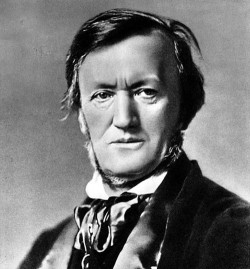 In the 19th century when no TV, radio or celebrity-driven pop music existed, musical theatre was the chief entertainment for the newly formed middle classes and its creators became the celebrities. The greatest of these emerged simultaneously: Verdi and Wagner, both born in the same year, 1813. Verdi continued the tradition of writing operas as musical entertainment, albeit raised to a level of perfection. But Wagner took it as his purpose in life to revolutionize the genre by the infusion of his own ideas, ambitions, problems — all that occupied his thoughts — and turning the music and drama, with a new emphasis on the orchestra, into one coherent unit. The end result was a distillation of his thought processes set to music that became a new entity, with words no longer depending on someone else but written by himself. So each of the works became autobiographical in a sense and dealt with universal issues giving them a timeless quality. There are dozens of fine recordings for every one of these operas, but in the following paragraphs I have selected just one CD set for each. Most of these are my favourites or, if more recent, are considered the best by renowned authorities.
In the 19th century when no TV, radio or celebrity-driven pop music existed, musical theatre was the chief entertainment for the newly formed middle classes and its creators became the celebrities. The greatest of these emerged simultaneously: Verdi and Wagner, both born in the same year, 1813. Verdi continued the tradition of writing operas as musical entertainment, albeit raised to a level of perfection. But Wagner took it as his purpose in life to revolutionize the genre by the infusion of his own ideas, ambitions, problems — all that occupied his thoughts — and turning the music and drama, with a new emphasis on the orchestra, into one coherent unit. The end result was a distillation of his thought processes set to music that became a new entity, with words no longer depending on someone else but written by himself. So each of the works became autobiographical in a sense and dealt with universal issues giving them a timeless quality. There are dozens of fine recordings for every one of these operas, but in the following paragraphs I have selected just one CD set for each. Most of these are my favourites or, if more recent, are considered the best by renowned authorities.
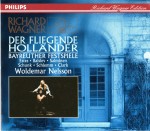 Wagner was born in Leipzig into a poor family, no prodigy and with next to no musical education. Hearing Beethoven, however, triggered a magic chord to becoming a composer. His young years were a series of frustrating attempts to earn a living made more difficult by an early marriage to actress Minna Planer. Pursued by his creditors and driven by ambition he took flight in 1840 and reached Paris. Here he wrote his first opera of consequence Der Fliegende Holländer(1841) inspired by a life-threatening sea voyage, but already encapsulating his principles of music drama. With anoverwhelming presence of stormy seas roaring in the orchestra the cursed Dutchman is really searching for erlösung or redemption in the figure of a loving wife who will be faithful and devoted. >>Der Fliegende Holländer: Simon Estes; Lisbeth Balslev; Matti Salminen; Bayreuther Festspiele 1985; Woldemar Nelsson; Philips 434 599-2, 2 CDs, also on DVD
Wagner was born in Leipzig into a poor family, no prodigy and with next to no musical education. Hearing Beethoven, however, triggered a magic chord to becoming a composer. His young years were a series of frustrating attempts to earn a living made more difficult by an early marriage to actress Minna Planer. Pursued by his creditors and driven by ambition he took flight in 1840 and reached Paris. Here he wrote his first opera of consequence Der Fliegende Holländer(1841) inspired by a life-threatening sea voyage, but already encapsulating his principles of music drama. With anoverwhelming presence of stormy seas roaring in the orchestra the cursed Dutchman is really searching for erlösung or redemption in the figure of a loving wife who will be faithful and devoted. >>Der Fliegende Holländer: Simon Estes; Lisbeth Balslev; Matti Salminen; Bayreuther Festspiele 1985; Woldemar Nelsson; Philips 434 599-2, 2 CDs, also on DVD
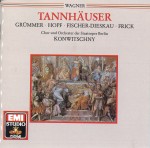 Both the themes of redemption and search for an ideal woman carry through in subsequent dramas. Written back home in Dresden, Tannhäuser (1844), isa more ambitious work in which Wagner explores man’s struggle between erotic (Venus) and spiritual (Elisabeth) love, the latter giving him redemption with her self-sacrifice. >>Tannhäuser, Dresden version; Hans Hopf; Elizabeth Grümmer; Dietrich Fischer-Dieskau; Berlin State Opera; Franz Kontwitschny; EMI 7 63214-2, 3 CDs
Both the themes of redemption and search for an ideal woman carry through in subsequent dramas. Written back home in Dresden, Tannhäuser (1844), isa more ambitious work in which Wagner explores man’s struggle between erotic (Venus) and spiritual (Elisabeth) love, the latter giving him redemption with her self-sacrifice. >>Tannhäuser, Dresden version; Hans Hopf; Elizabeth Grümmer; Dietrich Fischer-Dieskau; Berlin State Opera; Franz Kontwitschny; EMI 7 63214-2, 3 CDs
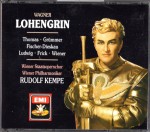 In Lohengrin(1848), his first major breakthrough, the basic theme is loneliness but here the search for an ideal woman ends in tragedy because of her inherent weakness and betrayal. Apart from all this, both of these “operas” also germinate his other life-long interests: German mythology, the legend of the Holy Grail (Lohengrin) and the role of the artist in society represented by his fascination with the Sängerkrieg or singing contest in Tannhäuser, the latter coming back much later in a different context in Die Meistersinger. >>Lohengrin: Jess Thomas, Elizabeth Grümmer, Dietrich Fischer-Dieskau, Christa Ludwig, Gottlob Frick, Vienna Philharmonic; Rudolf Kempe; EMI 7 49017 8, 3 CDs
In Lohengrin(1848), his first major breakthrough, the basic theme is loneliness but here the search for an ideal woman ends in tragedy because of her inherent weakness and betrayal. Apart from all this, both of these “operas” also germinate his other life-long interests: German mythology, the legend of the Holy Grail (Lohengrin) and the role of the artist in society represented by his fascination with the Sängerkrieg or singing contest in Tannhäuser, the latter coming back much later in a different context in Die Meistersinger. >>Lohengrin: Jess Thomas, Elizabeth Grümmer, Dietrich Fischer-Dieskau, Christa Ludwig, Gottlob Frick, Vienna Philharmonic; Rudolf Kempe; EMI 7 49017 8, 3 CDs
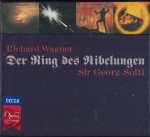 Unexpected events now interfered. When the revolutions breaking out all over Europe reached Dresden, Wagner, very much a revolutionary himself, took an active part on the losing side. In 1849cruel repression by the Saxon state forced him to escape in the night in disguise and seek asylum in Switzerland. Totally deprived of the means of existence, despondent, living on borrowed money from Franz Liszt who became his friend and supporter, he fell under the spell of Schopenhauer’s philosophy, Buddhism and later Nietzsche, and buried himself in the study of ancient German history, namely the Niebelungen Lied,an anonymous epic dating back to the time of Attila the Hun, and its hero Siegfried. Spurred into action again he wrote the text Siegfrieds Tod (Siegfried’s Death) and working backwards in time, more and more into mythology, he wrote the texts for the three preceding dramas.Much encouraged by Liszt he began composing his magnum opus, Der Ring des Nibelungen,now in proper sequence, and by 1856 he finished the score of Das Rheingold, Die Walküre and first two acts of Siegfried. At this instant however the score was laid to rest, the result of new life changing events. >>Der Ring des Nibelungen: Birgit Nilsson, Wolfgang Windgassen, Hans Hotter, Gustav Neidlinger, George London et al; Vienna Philharmonic; Sir Georg Solti, Decca 455-555, 14 CDs
Unexpected events now interfered. When the revolutions breaking out all over Europe reached Dresden, Wagner, very much a revolutionary himself, took an active part on the losing side. In 1849cruel repression by the Saxon state forced him to escape in the night in disguise and seek asylum in Switzerland. Totally deprived of the means of existence, despondent, living on borrowed money from Franz Liszt who became his friend and supporter, he fell under the spell of Schopenhauer’s philosophy, Buddhism and later Nietzsche, and buried himself in the study of ancient German history, namely the Niebelungen Lied,an anonymous epic dating back to the time of Attila the Hun, and its hero Siegfried. Spurred into action again he wrote the text Siegfrieds Tod (Siegfried’s Death) and working backwards in time, more and more into mythology, he wrote the texts for the three preceding dramas.Much encouraged by Liszt he began composing his magnum opus, Der Ring des Nibelungen,now in proper sequence, and by 1856 he finished the score of Das Rheingold, Die Walküre and first two acts of Siegfried. At this instant however the score was laid to rest, the result of new life changing events. >>Der Ring des Nibelungen: Birgit Nilsson, Wolfgang Windgassen, Hans Hotter, Gustav Neidlinger, George London et al; Vienna Philharmonic; Sir Georg Solti, Decca 455-555, 14 CDs
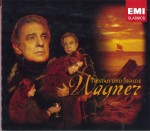 In 1857 Wagner and Minna were guests of a wealthy Zurich industrialist Otto Wesendonk whose wife Mathilde was a beautiful, talented and musical woman with whom Wagner fell in love. This passionate and ultimately doomed love affair inspired Tristan und Isolde, a music drama that transcended everything he’d done before. Its new chromatic world broke through conventional tonality and changed the course of Western music with far reaching effects on Liszt, Berlioz and even Debussy and Scriabin. No atonal music could possibly have happened without Tristan.Unresolved, unconsummated passion is the underlying essence and torment of Tristan and only death (“Liebestod”)can finally resolve the misery into the harmony of long-awaited tonality. All these events took their toll on his already teetering marriage. By the time he was pardoned and able to return to Germany in 1862 Minna left him, but Wagner never abandoned the responsibility of her welfare until her death. >>Tristan und Isolde: Nina Stemme; Placido Domingo; Mihoko Fujimora; René Pape; Royal Opera House, Covent Garden; Antonio Pappano EMI 5 58006-2, 3 CDs
In 1857 Wagner and Minna were guests of a wealthy Zurich industrialist Otto Wesendonk whose wife Mathilde was a beautiful, talented and musical woman with whom Wagner fell in love. This passionate and ultimately doomed love affair inspired Tristan und Isolde, a music drama that transcended everything he’d done before. Its new chromatic world broke through conventional tonality and changed the course of Western music with far reaching effects on Liszt, Berlioz and even Debussy and Scriabin. No atonal music could possibly have happened without Tristan.Unresolved, unconsummated passion is the underlying essence and torment of Tristan and only death (“Liebestod”)can finally resolve the misery into the harmony of long-awaited tonality. All these events took their toll on his already teetering marriage. By the time he was pardoned and able to return to Germany in 1862 Minna left him, but Wagner never abandoned the responsibility of her welfare until her death. >>Tristan und Isolde: Nina Stemme; Placido Domingo; Mihoko Fujimora; René Pape; Royal Opera House, Covent Garden; Antonio Pappano EMI 5 58006-2, 3 CDs
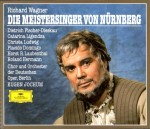 Upon his return to Germany, and almost as a catharsis from Tristan, his mind turned again to the Middle Ages, but this time to a much happier subject, a comedy based on the archaic guild system and a new kind of artist, a poet/composer trying to establish himself by entering a singing contest. Die Meistersinger von Nürnbergis centred on a romantic love story and the music is in a major key, a glorious C major, the complete opposite to Tristan. Interestingly enough the real hero is Hans Sachs, an elderly master of great talent, intellect, wisdom and a widower also attracted to the heroine, but being too old for her, has to give her up. It is obvious that Wagner himself is Hans Sachs at this point longing for a kindred spirit, a younger woman who will shortly appear on the scene. >>Die Meistersinger von Nürnberg; Dietrich Fischer-Dieskau; Caterina Ligendza; Christa Ludwig; Placido Domingo; Berlin State Opera; Eugen Jochum; DG 415 278-2 4 CDs
Upon his return to Germany, and almost as a catharsis from Tristan, his mind turned again to the Middle Ages, but this time to a much happier subject, a comedy based on the archaic guild system and a new kind of artist, a poet/composer trying to establish himself by entering a singing contest. Die Meistersinger von Nürnbergis centred on a romantic love story and the music is in a major key, a glorious C major, the complete opposite to Tristan. Interestingly enough the real hero is Hans Sachs, an elderly master of great talent, intellect, wisdom and a widower also attracted to the heroine, but being too old for her, has to give her up. It is obvious that Wagner himself is Hans Sachs at this point longing for a kindred spirit, a younger woman who will shortly appear on the scene. >>Die Meistersinger von Nürnberg; Dietrich Fischer-Dieskau; Caterina Ligendza; Christa Ludwig; Placido Domingo; Berlin State Opera; Eugen Jochum; DG 415 278-2 4 CDs
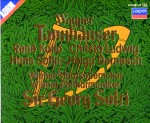 Success and financial remuneration were slowin coming. Tannhäuserin Paris in 1861 was a dismal failure, riots disrupted the performance and the show had to be shut down almost at once. >>Tannhäuser, Paris version: René Kollo, Helga Dernesch, Hans Sotin, Christa Ludwig, Vienna State Opera Chorus and Orchestra; Sir Georg Solti; LONDON 414 581-2 3CDs
Success and financial remuneration were slowin coming. Tannhäuserin Paris in 1861 was a dismal failure, riots disrupted the performance and the show had to be shut down almost at once. >>Tannhäuser, Paris version: René Kollo, Helga Dernesch, Hans Sotin, Christa Ludwig, Vienna State Opera Chorus and Orchestra; Sir Georg Solti; LONDON 414 581-2 3CDs
But all of a sudden in 1864, as if by divine intervention, an emissary appeared at Wagner’s doorstep from Ludwig II, King of Bavaria, who became so enamoured of his work that he offered to give him unlimited financial support and bring him to his Court in Munich. This “miracle” enabled Wagner to complete the Ring (the final act of Siegfried and the entire Götterdämmerung)and bring his longtime dream of building a festival theatre performing his works only, under his creative control and by his specifications, to fruition. Court intrigues, however, interfered mainly because of the king’s extravagance in nearly bankrupting the state and Wagner’s new liaison with Cosima von Bülow, 25 years his junior and Liszt’s daughter, married to Hans von Bülow, a noted conductor. Wagner had to retreat again to Switzerland, to Lucerne in a rented villa called Triebschen where he continued to work, live with and marry Cosima (1870) who bore him a number of children, until he was able to move to Bayreuth where his Festspielhaus was built. In 1876 it opened with the complete Ring to an invited audience of notables from all over Europe, including royalty and even the Kaiser of the newly united Germany.
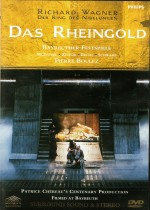 The real message of the Ring goes far beyond mythology. It encompasses the whole of society at the rise of capitalism. The ruthless acquisition of wealth creates plutocracy that renounces love (Alberich) and enslaves the working class (Nibelungs). The decadent aristocracy (Gods) eventually self-destructs and mankind can only be redeemed by a new kind of human who is free (Siegfried), embraces and even dies for love (Brunnhilde’s self-immolation). To illustrate this real meaning, French director Patrice Chereau created a revolutionary new vision in 1976 for the first time in 100 years, the Centennial Bayreuth Ring. >>Der Ring des Nibelungen: Gwyneth Jones, Donald McIntyre, Peter Hoffmann, Jeannine Altmeyer, Manfred Jung et al; Bayreuther Festspiele 1976; Pierre Boulez; Philips 475 7960 12 CDs, also on DVD
The real message of the Ring goes far beyond mythology. It encompasses the whole of society at the rise of capitalism. The ruthless acquisition of wealth creates plutocracy that renounces love (Alberich) and enslaves the working class (Nibelungs). The decadent aristocracy (Gods) eventually self-destructs and mankind can only be redeemed by a new kind of human who is free (Siegfried), embraces and even dies for love (Brunnhilde’s self-immolation). To illustrate this real meaning, French director Patrice Chereau created a revolutionary new vision in 1976 for the first time in 100 years, the Centennial Bayreuth Ring. >>Der Ring des Nibelungen: Gwyneth Jones, Donald McIntyre, Peter Hoffmann, Jeannine Altmeyer, Manfred Jung et al; Bayreuther Festspiele 1976; Pierre Boulez; Philips 475 7960 12 CDs, also on DVD
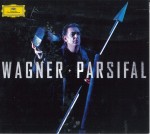 Wagner’s remaining years were bathed in glory with his family, Liszt, and friends such as Herrmann Levy who conducted Parsifal, Wagner’s last utterance in music drama. Here Wagner returned to his favourite theme of the Holy Grail, a monument to Christianity that no one has equalled before or since. The main ideas behind Parsifal are temptation by evil, original sin and its punishment, redemption by an innocent, fearless youth, a “holy fool” (Parsifal) who can conquer the evil (Klingsor) and redeem the sinners (King Amfortas and Kundry) upon whom he purifies the Order and becomes the new king of the Knights of the Holy Grail. Wagner’s Parsifal was indeed a crowning achievement, a “revelation in music drama,” to quote Liszt, his father-in-law who survived him by three years. Wagner died on February 13, 1883, in Venice where he and his family moved for health reasons, not quite 70. Cosima wouldn’t leave his side, refusing to eat for two days; however she survived her husband by many years, took over the Bayreuth festival and died in 1931, at age 93. >>Parsifal: Placido Domingo, Falk Struckmann, Waltraud Meier, Franz-Josef Selig et al; Vienna State Opera; Christian Thielemann, DG 477 6006 4 CDs
Wagner’s remaining years were bathed in glory with his family, Liszt, and friends such as Herrmann Levy who conducted Parsifal, Wagner’s last utterance in music drama. Here Wagner returned to his favourite theme of the Holy Grail, a monument to Christianity that no one has equalled before or since. The main ideas behind Parsifal are temptation by evil, original sin and its punishment, redemption by an innocent, fearless youth, a “holy fool” (Parsifal) who can conquer the evil (Klingsor) and redeem the sinners (King Amfortas and Kundry) upon whom he purifies the Order and becomes the new king of the Knights of the Holy Grail. Wagner’s Parsifal was indeed a crowning achievement, a “revelation in music drama,” to quote Liszt, his father-in-law who survived him by three years. Wagner died on February 13, 1883, in Venice where he and his family moved for health reasons, not quite 70. Cosima wouldn’t leave his side, refusing to eat for two days; however she survived her husband by many years, took over the Bayreuth festival and died in 1931, at age 93. >>Parsifal: Placido Domingo, Falk Struckmann, Waltraud Meier, Franz-Josef Selig et al; Vienna State Opera; Christian Thielemann, DG 477 6006 4 CDs
In spite of the many controversies surrounding Wagner during his lifetime and ever since, his immeasurable achievement in music and theatre and his enormous influence on the future of his art ensure him a place in Parnassus.
Janos Gardonyi is a frequent contributor to DISCoveries.



